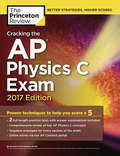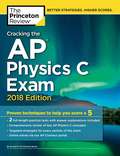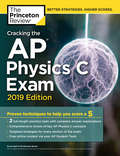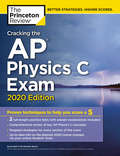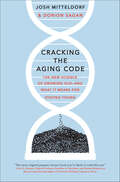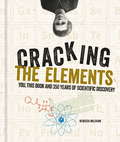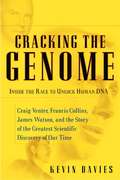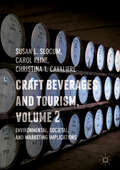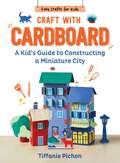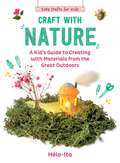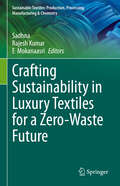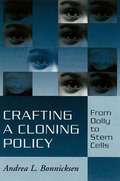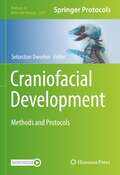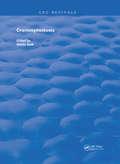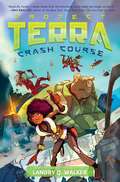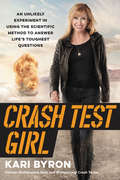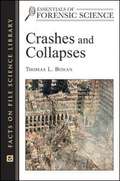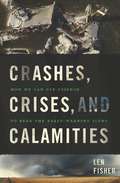- Table View
- List View
Cracking the AP Physics C Exam, 2017 Edition: Proven Techniques to Help You Score a 5
by Princeton ReviewEVERYTHING YOU NEED TO HELP SCORE A PERFECT 5. Equip yourself to ace the AP Physics C Exam with The Princeton Review's comprehensive study guide--including thorough content reviews, targeted strategies for every question type, access to our AP Connect portal online, and 2 full-length practice tests with complete answer explanations. This eBook edition has been optimized for on-screen viewing with cross-linked questions, answers, and explanations.Techniques That Actually Work.* Tried-and-true strategies to help you avoid traps and beat the test* Tips for pacing yourself and guessing logically* Essential tactics to help you work smarter, not harderEverything You Need to Know to Help Achieve a High Score.* Comprehensive content reviews for all test topics* Up-to-date information on the 2017 AP Physics C Exam* Engaging activities to help you critically assess your progress* Access to AP Connect, our online portal for helpful pre-college information and exam updatesPractice Your Way to Excellence.* 2 full-length practice tests with detailed answer explanations* Practice drills at the end of each content review chapter* Step-by-step walk-throughs of sample Mechanics and Electricity & Magnetism exam questions
Cracking the AP Physics C Exam, 2018 Edition: Proven Techniques to Help You Score a 5
by Princeton ReviewEVERYTHING YOU NEED TO HELP SCORE A PERFECT 5! Ace the AP Physics C Exam with this comprehensive study guide—including 2 full-length practice tests with complete answer explanations, thorough content reviews, targeted exam strategies, and access to our AP Connect portal online. This eBook edition has been optimized for on-screen reading with cross-linked questions, answers, and explanations. Written by the experts at The Princeton Review, Cracking the AP Physics C Exam arms you to take on the test and achieve your highest possible score.Everything You Need to Know to Help Achieve a High Score.• Comprehensive content reviews for all test topics• Tons of charts and figures to illustrate important concepts• Engaging activities to help you critically assess your progress• Access to AP Connect, our online portal for helpful pre-college information and exam updatesPractice Your Way to Excellence.• 2 full-length practice tests with detailed answer explanations• Practice drills at the end of each content review chapter• Step-by-step walk-throughs of sample Mechanics and Electricity & Magnetism exam questions• Diagnostic answer key to help focus your studiesTechniques That Actually Work.• Tried-and-true strategies to help you avoid traps and beat the test• Tips for pacing yourself and guessing logically• Essential tactics to help you work smarter, not harder
Cracking the AP Physics C Exam, 2019 Edition: Practice Tests & Proven Techniques to Help You Score a 5 (College Test Preparation)
by Princeton ReviewEVERYTHING YOU NEED TO HELP SCORE A PERFECT 5! Ace the AP Physics C Exam with this comprehensive study guide—including 2 full-length practice tests with complete answer explanations, thorough content reviews, targeted exam strategies, and bonus online extras. Everything You Need to Know to Help Achieve a High Score.• Comprehensive content reviews for all test topics• Tons of charts and figures to illustrate important concepts• Diagnostic answer keys to help focus your studies• Access to online study plans, a handy list of key terms and concepts, helpful pre-college information, and morePractice Your Way to Excellence.• 2 full-length practice tests with detailed answer explanations• Practice drills at the end of each content review chapter• Step-by-step walk-throughs of sample Mechanics and Electricity & Magnetism exam questions• Diagnostic answer key to help focus your studiesTechniques That Actually Work.• Tried-and-true strategies to help you avoid traps and beat the test• Tips for pacing yourself and guessing logically• Essential tactics to help you work smarter, not harderWritten by the experts at The Princeton Review, Cracking the AP Physics C Exam arms you to take on the test and achieve your highest possible score.
Cracking the AP Physics C Exam, 2020 Edition: Practice Tests & Proven Techniques to Help You Score a 5 (College Test Preparation)
by The Princeton ReviewEVERYTHING YOU NEED TO HELP SCORE A PERFECT 5! Ace the AP Physics C Exam with this comprehensive study guide—including 2 full-length practice tests with complete answer explanations, thorough content reviews, targeted exam strategies, and bonus online extras. Techniques That Actually Work. • Tried-and-true strategies to help you avoid traps and beat the test • Tips for pacing yourself and guessing logically • Essential tactics to help you work smarter, not harderEverything You Need to Know to Help Achieve a High Score. • Comprehensive content review for all test topics • Tons of charts and figures to illustrate concepts • Up-to-date info on the planned 2020 course changes via your online Student Tools • Access to online study plans, a handy list of equations and formulas, helpful pre-college information, and morePractice Your Way to Excellence.• 2 full-length practice tests with detailed answer explanations • Practice drills at the end of each content review chapter • Step-by-step walk-throughs of sample Mechanics and Electricity & Magnetism exam questionsWritten by the experts at The Princeton Review, Cracking the AP Physics C Exam arms you to take on the test and achieve your highest possible score.
Cracking the Aging Code: The New Science of Growing Old—and What It Means for Staying Young
by Dorion Sagan Josh MitteldorfA revolutionary examination of why we age, what it means for our health, and how we just might be able to fight it.In Cracking the Aging Code, theoretical biologist Josh Mitteldorf and award-winning writer and ecological philosopher Dorion Sagan reveal that evolution and aging are even more complex and breathtaking than we originally thought. Using meticulous multidisciplinary science, as well as reviewing the history of our understanding about evolution, this book makes the case that aging is not something that “just happens,” nor is it the result of wear and tear or a genetic inevitability. Rather, aging has a fascinating evolutionary purpose: to stabilize populations and ecosystems, which are ever-threatened by cyclic swings that can lead to extinction. When a population grows too fast it can put itself at risk of a wholesale wipeout. Aging has evolved to help us adjust our growth in a sustainable fashion as well as prevent an ecological crisis from starvation, predation, pollution, or infection.This dynamic new understanding of aging is provocative, entertaining, and pioneering, and will challenge the way we understand aging, death, and just what makes us human.
Cracking the Einstein Code: Relativity and the Birth of Black Hole Physics
by Fulvio MeliaAlbert Einstein's theory of general relativity describes the effect of gravitation on the shape of space and the flow of time. But for more than four decades after its publication, the theory remained largely a curiosity for scientists; however accurate it seemed, Einstein's mathematical code--represented by six interlocking equations--was one of the most difficult to crack in all of science. That is, until a twenty-nine-year-old Cambridge graduate solved the great riddle in 1963. Roy Kerr's solution emerged coincidentally with the discovery of black holes that same year and provided fertile testing ground--at long last--for general relativity. Today, scientists routinely cite the Kerr solution, but even among specialists, few know the story of how Kerr cracked Einstein's code. Fulvio Melia here offers an eyewitness account of the events leading up to Kerr's great discovery. Cracking the Einstein Code vividly describes how luminaries such as Karl Schwarzschild, David Hilbert, and Emmy Noether set the stage for the Kerr solution; how Kerr came to make his breakthrough; and how scientists such as Roger Penrose, Kip Thorne, and Stephen Hawking used the accomplishment to refine and expand modern astronomy and physics. Today more than 300 million supermassive black holes are suspected of anchoring their host galaxies across the cosmos, and the Kerr solution is what astronomers and astrophysicists use to describe much of their behavior. By unmasking the history behind the search for a real world solution to Einstein's field equations, Melia offers a first-hand account of an important but untold story. Sometimes dramatic, often exhilarating, but always attuned to the human element, Cracking the Einstein Code is ultimately a showcase of how important science gets done.
Cracking the Elements (Cracking Ser.)
by Rebecca MilehamFrom the earliest-known elements to those named in 2016, this book takes a comprehensive look at the development of the periodic table - and reveals untold stories, unsung pioneers and plenty of fascinating science along the way. In twelve illustrated chapters, the book makes sense of the patterns and groups within the periodic table, introducing each of the 118 known elements individually and exploring questions including:- Why did the history of fizzy water give early chemistry a sparkle?- How did hydrogen reveal the structure of the atom?- What was the Bunsen burner's role in discovering new elements?- Which of the alkaline earth metals accounts for a kilogramme of your weight?- Why is Marie Curie such a scientific star?- How do tungsten and vanadium explain the secret of super-sharp Syrian swords?- Who discovered the most elements in the periodic table?- What made nihonium, element 113, such a wonderful new year's gift for Japan?- Is glass a liquid or a solid?- How did nitrogen fulfill the alchemists' dream?- Would you have smeared antimony on your face if you'd lived in ancient Egypt?- Why might naked mole rats have clues for surviving a heart attack?- How did the Haya people of Tanzania make steel 1500 years ago?- What makes xenon a great anaesthetic - and why can't all patients use it?- Might there be a pattern in yet undiscovered elements beyond number 118?
Cracking the Elements (Cracking Series)
by Rebecca MilehamFrom the earliest-known elements to those named in 2016, this book takes a comprehensive look at the development of the periodic table - and reveals untold stories, unsung pioneers and plenty of fascinating science along the way. In twelve illustrated chapters, the book makes sense of the patterns and groups within the periodic table, introducing each of the 118 known elements individually and exploring questions including:- Why did the history of fizzy water give early chemistry a sparkle?- How did hydrogen reveal the structure of the atom?- What was the Bunsen burner's role in discovering new elements?- Which of the alkaline earth metals accounts for a kilogramme of your weight?- Why is Marie Curie such a scientific star?- How do tungsten and vanadium explain the secret of super-sharp Syrian swords?- Who discovered the most elements in the periodic table?- What made nihonium, element 113, such a wonderful new year's gift for Japan?- Is glass a liquid or a solid?- How did nitrogen fulfill the alchemists' dream?- Would you have smeared antimony on your face if you'd lived in ancient Egypt?- Why might naked mole rats have clues for surviving a heart attack?- How did the Haya people of Tanzania make steel 1500 years ago?- What makes xenon a great anaesthetic - and why can't all patients use it?- Might there be a pattern in yet undiscovered elements beyond number 118?
Cracking the Genome: Inside the Race to Unlock Human DNA
by Kevin DaviesWriting for a popular audience, Davies recounts the race to unravel the human genome sequence. The narrative is equally concerned with the institutional politics of the public and private projects as it is with the scientific advances and achievements of the researchers. Annotation (c)2003 Book News, Inc., Portland, OR (booknews.com)
Craft Beverages and Tourism, Volume 2: Environmental, Societal, and Marketing Implications
by Carol Kline Susan L. Slocum Christina T. CavaliereThis volume applies a mix of qualitative and quantitative research and case studies to analyze the role that the craft beverage industry plays within society at large. It targets important themes such as environmental conservation and social responsibility, as well as the psychology of the craft beer drinker and their impact on tourism marketing. This volume advances marketing, hospitality, and leisure studies research for academics, industry experts, and emerging entrepreneurs.
Craft with Cardboard: A Kid's Guide to Constructing a Miniature City (Easy Crafts for Kids)
by Tiffanie PichonPut yourself in the shoes of a real architect and create your very own city out of cardboard! In this guided collection, young crafters and artists will find step-by-step instructions and full-color photographs that will aid them in creating a whole city (people and vehicles included!) out of cardboard. Author and artist Tiffanie Pichon opens with encouraging words that will inspire crafters to pay closer attention to their surroundings as they move through their city or town. The architecture—from roof to window—the sidewalks, parks, and even the jobs people are doing while they walk or drive through a city may inspire their creations as they construct their very own city out of recycled materials, like cardboard. The projects featured throughout this fully illustrated book will come together to create a neighborhood, but may also inspire future projects such as DIY rural towns and farms. Types of creations include houses and stores, towers and skyscrapers, factories, people and animals, vehicles, mountains, trees, benches, and more—all requiring the most basic supplies (tape or glue, scissors, paints or markers, rulers, colored paper, egg cartons, etc.) and whatever recycled or natural materials the crafter wants to use!
Craft with Nature: A Kid's Guide to Creating with Materials from the Great Outdoors (Easy Crafts for Kids #1)
by Héloïse Charier-MaurelEnter the world of an artist with a natural spirit in this collection of crafts inspired by your surroundings! In this guided collection, young crafters and artists will find step-by-step instructions and full-color photographs that will aid them in creating decorations and playful projects using elements of the natural world. Author and artist Hélo-Ita opens with encouraging words that will inspire crafters to pay closer attention to the environment and all it has to offer when outdoors, whether they&’re on a serene hiking path in a forest, dipping into the waves at the beach, or simply playing in their own background or walking to school. You never know which materials you may find! The projects featured throughout this fully-illustrated book can be created as displayed on the page and may inspire future crafts. Types of creations include greeting cards, sculptures, light displays, kawaii rock pets, mobiles, ships in bottles, and tea light villages—all requiring the most basic supplies (tape or glue, scissors, paints or pens, thread) and whatever natural materials you source!
Craft with Recycling: A Kid's Guide to Creating with Upcycled Materials (Easy Crafts for Kids #2)
by Stéphanie BoulayIn this guided collection, young crafters and artists will find step-by-step instructions and full-color photographs that will aid them in creating decorations and playful projects using elements they have designated for reuse or upcycling. Author and artist Stéphanie Boulay, known as Lucimari, opens with encouraging words that will inspire crafters to pay closer attention to their surroundings for materials that may otherwise be thrown away, such as cans, bottles, scraps of paper or felt, unused and mismatched yarn. You never know which materials may be given a second life! The projects featured throughout this fully illustrated book can be created as displayed on the page and may inspire future crafts. Types of creations include masks, figurines or toys, mobiles, desk organizers, and more.
Crafting Sustainability in Luxury Textiles for a Zero-Waste Future (Sustainable Textiles: Production, Processing, Manufacturing & Chemistry)
by Rajesh Kumar Sadhna E MokanaasriIn an era where environmental consciousness is rapidly becoming a priority, the luxury textile industry stands at a crucial crossroads. As consumers increasingly demand products that not only offer elegance and opulence but also align with sustainable values, luxury brands are facing a paradigm shift in their approach. This shift towards sustainability is not merely a trend but a fundamental reevaluation of the industry's practices, driven by a growing awareness of the environmental impact of textile manufacturing and consumption. This contributed volume explores this transformative journey, investigating how luxury and sustainability can harmoniously coexist to shape a future where opulence is synonymous with environmental stewardship. The book examines the intricate relationship between luxury textiles and sustainability, offering insights, analyses, and practical solutions for crafting a zero-waste future in the high-end fashion industry. The book serves as a valuable resource for scholars, practitioners, and policymakers seeking to navigate the complexities of sustainable textile production while maintaining the essence of luxury and craftsmanship. Through a collaborative effort, the work presented here sets the stage for a future where luxury textiles captivate the senses and inspire a profound sense of environmental responsibility, paving the way toward a zero-waste future in high-end fashion.
Crafting a Cloning Policy: From Dolly to Stem Cells
by Andrea L. BonnicksenPolitical scientist and well-known expert on reproductive issues, Andrea L. Bonnicksen examines the political reaction this new-born science and the efforts to construct cloning policy.
Craniofacial Development: Methods and Protocols (Methods in Molecular Biology #2403)
by Sebastian DworkinThis volume explores scientific methodologies currently employed to integrate observational developmental biology, tissue explant and cell-based approaches and genetic/molecular technologies to develop a holistic understanding of craniofacial development. Chapters guide readers through the use of disparate models to study formation of the head and face (c. elegans, zebrafish, mouse, alongside human imaging approaches), together with cell culture, tissue explant and in vivo cell imaging and analysis techniques. At the molecular level, chapters include analysing gene expression using in-situ hybridisation and single-cell RNA-Sequencing (scRNA-SEQ), as well as genetic modification techniques such as CRISPR/Cas9-mediated deletion. Written in the format of the highly successful Methods in Molecular Biology series, each chapter includes an introduction to the topic, lists necessary materials and reagents, includes tips on troubleshooting and known pitfalls, and step-by-step, readily reproducible protocols. Authoritative and cutting-edge, Craniofacial Development: Methods and Protocols aims to be a guide in the field of craniofacial development for senior and new researchers looking to expand their existing research programs to encompass novel techniques.
Craniosynostosis (Routledge Revivals)
by Guido GalliPublished in 1984, this book explores craniosynostosis, providing a synthesis of diagnostic aspects and the therapeutic orientation derived from both the evolution of pathogenetic theory, and the necessity to recognize and treat affected children as early as possible. Focusing on craniosynostosis in the first year of life the books has a practical, clinical and applicative content and will be of use to the practicing physician as well as the specialist reader.
Crap Taxidermy
by Kat SuA humorous look at what happens when taxidermy goes terribly wrong, by the founder of the hit website crappytaxidermy.com.A relaxed toad enjoying a smoke and a brew. A cat with eerily flexible front legs. A smiling lion with receding gums. Whether you choose to laugh or cringe at these spectacularly bad attempts at taxidermy, you won't be able to tear your eyes away from the curiosities inside. This volume brings together the very best of the worst (along with a DIY "Stuff Your Own Mouse" lesson by an Insect Preparator from the American Museum of Natural History), showcasing the most perverse yet imaginative anatomical reconstructions of the animal kingdom you'll ever see.From the Hardcover edition.
Crash Course #1
by Keith Zoo Landry Q. WalkerGuardians of the Galaxy meets Minecraft in this hilarious sci-fi series for middle grade readers. TERRAFORMING 101 - Learn the basics of FARMING IN SPACE!! Open to first year students. For eleven-year-old Elara, life at the Academy of Terraforming Arts is a lot tougher—and stranger—than she expected. Her latest experiment accidentally blew up the moon. Her roommate, Clare, is a mute intergalactic sponge. And no one at her new school knows what it's like to grow up on a planet called "Nowhere." But if the greatest Planetary Designers in the galaxy made it through their first year, then so can she.Based on the real science behind terraforming, this action-packed story mixes world-building adventures with side-splitting humor, plus a dash of intergalactic madness.
Crash Test Girl: An Unlikely Experiment in Using the Scientific Method to Answer Life’s Toughest Questions
by Kari ByronKari Byron—former host of the wildly popular, iconic cult classic MythBusters—shows how to crash test your way through life, no lab coat required. Kari Byron’s story hasn’t been a straight line. She started out as a broke artist living in San Francisco, writing poems on a crowded bus on the way to one of her three jobs. Many curve balls, unexpected twists, and yes, literal and figurative explosions later, and she’s one of the world’s most respected women in science entertainment, blowing stuff up on national television and getting paid for it! In Crash Test Girl, Kari reveals her fascinating life story on the set of MythBusters and beyond. With her signature gusto and roll-up-your-sleeves enthusiasm, she invites readers behind the duct tape and the dynamite, to the unlikely friendships and low-budget sets that turned a crazy idea into a famously inventive show with a rabid fanbase. The truth is, Mythbusters was never meant to be a science show. But attaching a rocket to a car, riding a motorcycle on water, or lighting 500 pounds of coffee creamer on fire requires a decent understanding of chemistry, physics, and engineering. Thus, the cast and crew brought in the scientific method to work through each problem: Question. Hypothesize. Experiment. Analyze. Conclude. And as Kari came to learn in her own life, not only is the scientific method the best approach for busting myths, it’s also the perfect tool for solving everyday issues, including:Career · Love · Creativity · Setbacks · Money · Sexuality · Depression · BraveryCrash Test Girl reminds us that science is for everyone, as long as you’re willing to strap in, put on your safety goggles, hit a few walls, and learn from the results. Using a combination of methodical experimentation and unconventional creativity, you’ll come to the most important conclusion of all: In life, sometimes you crash and burn, but you can always crash and learn.
Crashes and Collapses
by Thomas L. BohanCrashes and Collapses includes a collection of stories based on real cases involving the forensic engineering sciences. It may surprise those whose view of forensic science has been formed by those television shows to learn that a large fraction, perhaps most, of forensic work involves the engineering sciences and that this has been the case since ancient times. This book is about some of that work and is aimed at introducing curious adults as well as middle- and high-school students to the world of forensic science in such a way that they will be better able to evaluate what they hear and see about forensic investigations and also about the broader world within which these investigations take place.
Crashes, Crises, and Calamities: How We Can Use Science to Read the Early-Warning Signs
by Len FisherWhy do certain civilizations, societies, and ecosystems collapse? How does the domino effect relate to the credit crunch? When can mathematics help explain marriage? And how on earth do toads predict earthquakes? The future is uncertain. But science can help foretell what lies ahead. Drawing on ecology and biology, math and physics, Crashes, Crises, and Calamities offers four fundamental tools that scientists and engineers use to forecast the likelihood of sudden change: stability, catastrophe, complexity, and game theories. In accessible prose, Len Fisher demonstrates how we can foresee and manage events that might otherwise catch us by surprise. At the cutting edge of science, Fisher helps us find ways to act before a full-fledged catastrophe is upon us. Crashes, Crises, and Calamities is a witty and informative exploration of the chaos, complexity, and patterns of our daily lives.
Crayfish in Europe as Alien Species (Advances In Crustacean Research Ser. #Vol. 11)
by Francesca Gherardi David M. HoldichFrom the third international workshop on the subject (U. of Florence, 1997), come 18 papers reviewing the issue of alien crayfish decimating the relatively few native species in European freshwater environments. In a historical and taxonomic context, the initial paper explains why such homogenizatio
Crazy Contraptions (Fountas & Pinnell LLI Purple #Level S)
by Jordan BrownFailure is fun! Or at least it can be when you're creating a Rube Goldberg Machine (RGM). These crazy homemade machines use a bunch of silly steps and chain reactions to accomplish a simple task. Learn the secrets of how to make your own.
